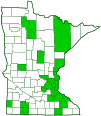milkweed stem weevil
(Rhyssomatus lineaticollis)
Conservation • Description • Habitat • Ecology • Distribution • Taxonomy
|
|
||||||||||||||
Description |
Milkweed stem weevil is a small snout beetle. It occurs in the United States from Maine and Florida west to Utah and Arizona, and in Canada in Quebec and Ontario. Adults feed on the leaves, stems, and pods of mostly common milkweed but also on other milkweed species. Larvae feed on the stems of the same plants. Adults are black, hard bodied, robust, oval, and 3⁄16″ to ¼″ (5.5 to 6.5 mm) long. They are convex when viewed from the side. They are almost completely free of hairs and scales. The head is greatly elongated between the eyes and the mouth parts form a conspicuous snout (rostrum). The rostrum is almost cylinder-shaped, projected forward, and slightly bent downward. It is shorter than the head and thorax combined. The antennae are short. slender, elbowed, and reddish. They have 11 segments. The last 3 segments are expanded and form a club. The thorax is composed of three segments. The first segment (prothorax) is large and prominent and appears to be the entire thorax. It is covered by a saddle-shaped plate (pronotum). The pronotum is wider than long, strongly arched at the sides, and narrower than the hardened wing covers (elytra). It is covered with deep, longitudinal grooves. The grooves are parallel to the midline, not oblique. The elytra completely cover the abdomen. They are grooved and have narrow ridges between the grooves. Within the grooves there are two rows of deep pits (punctures). The legs are mostly black except for the last part of the leg (tarsus), corresponding to the foot, which is reddish. The tarsus has 5 segments, but the fourth segment is very small and is concealed within the lobes at the end of the third segment, making it appear to have just 4 segments. |
Size |
Total length: 3⁄16″ to ¼″ (5.5 to 6.5 mm) |
Similar Species |
Habitat |
Fields, prairies, and pastures. Mostly common milkweed but also other milkweeds. |
Ecology |
Season |
May to August |
Behavior |
|
Life Cycle |
The female chews several holes in a line near the base of the stem of a host plant. She lays a single egg in each hole. |
Larva Food |
Stems of milkweeds |
Adult Food |
Leaves, stems, and pods of milkweeds. |
Distribution |
||
|
Sources |
|
| 11/5/2024 | ||
Occurrence |
||
|
||
Taxonomy |
|
Order |
Coleoptera (Beetles) |
Suborder |
Polyphaga (Water, Rove, Scarab, Long-horned, Leaf, and Snout Beetles) |
Infraorder |
Cucujiformia |
Superfamily |
Curculionoidea (snout and bark beetles) |
Family |
Curculionidae (true weevils) |
Subfamily |
Molytinae |
Tribe |
Cleogonini |
Genus |
Rhyssomatus |
Subordinate Taxa |
|
|
|
Synonyms |
|
Rhynchaenus linealicolis |
|
Common Names |
|
common milkweed stem weevil milkweed curculio milkweed stem weevil |
|
Glossary
Elytra
The hardened or leathery forewings of beetles used to protect the fragile hindwings, which are used for flying. Singular: elytron.
Pronotum
The exoskeletal plate on the upper side of the first segment of the thorax of an insect.
Rostrum
The stiff, beak-like projection of the carapace or prolongation of the head of an insect, crustacean, or cetacean.
Visitor Photos |
||
Share your photo of this insect. |
||
This button not working for you? |
||
Alfredo Colon |
||
 |
||
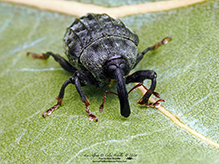 |
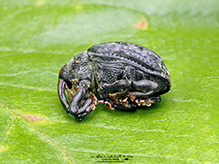 |
|
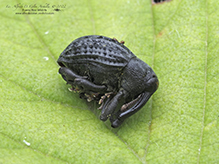 |
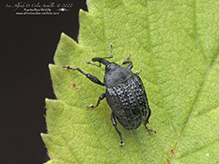 |
|
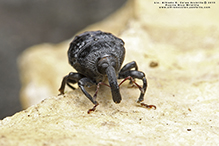 |
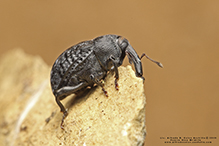 |
|
Elaine Morrison |
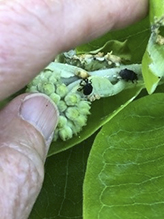 |
MinnesotaSeasons.com Photos |
||
|
||
|
||

Slideshows |
|

Visitor Videos |
||
Share your video of this insect. |
||
This button not working for you? |
||
|
Other Videos |
||
Milkweed Stem Weevil (Curculionidae: Rhyssomatus lineaticollis) |
About
Jun 26, 2010 Photographed at the Rydell NWR, Minnesota (25 June 2010). |

Visitor Sightings |
||
Report a sighting of this insect. |
||
This button not working for you? |
||
Shelly Breitzmann |
Location: Town of Superior Wisconsin Have removed 40 from milkweed plants in the last week as well as a cluster of young. Unusual to have so many. The milkweed stem weevil's defense is apparently playing dead and dropping to the ground. When they drop, they may continue playing dead for up to a few minutes and then are back on the move. |
|
Alfredo Colon |
Location: Albany, NY |
 |
| Elaine Morrison 6/23/2023 |
Location: Saint Louis Park, MN |
 |
| Alfredo Colon 8/5/2022 |
Location: Albany, NY |
 |
| Alfredo Colon 8/8/2019 |
Location: Woodbury, MN |
 |
MinnesotaSeasons.com Sightings |
||
|

Created: 11/19/2020 Last Updated: © MinnesotaSeasons.com. All rights reserved. |
